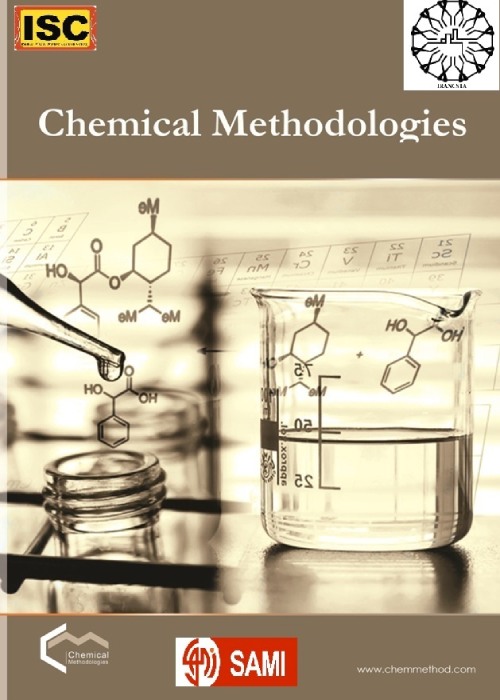فهرست مطالب
Chemical Methodologies
Volume:1 Issue: 1, May-Jun 2017
- تاریخ انتشار: 1396/03/11
- تعداد عناوین: 6
-
-
Pages 1-11A simple, highly efficient and green procedure for the condensation of aryl and alkyl 1,2-diamines with α-diketones in the presence of catalytic amount of silica boron sulfonic acid (SBSA) at room temperature is described. By Using this method, quinoxaline derivatives as biologically interesting compounds are produced in high to excellent yields and short reaction times.Keywords: Boron sulfonic acid (BSA), quinoxaline synthesis, 1, 2-Diamine, α-diketone, Green chemistry
-
Pages 12-27In this study, Copper-tetraaminophthalocyanine (CuTAP) was supported on polyvinylcholoride by reflux condition to produce heterogeneous recovarable catalyst. This catalyst was characterized using Fourier-transform infrared spectroscopy (FT-IR), X-ray diffraction (XRD), Scanning electron microscopy (SEM) and UV-vis spectroscopy. The results showed that the photocatalytic degradation of methyl orange was performed in mild conditions at ambient pressure and temperature under visible light. The synthesized catalyst could be readily separated from the catalytic system by centrifuging and loss of activity was negligible when the catalyst was recovered in four consecutive cycles. The effects of operational various factors such as catalyst amount, initial dye concentration and contact time on degradation of methyl orange were investigated. Optimization results showed that maximum degradation of methyl orange efficiency 98.6 % was achieved at the optimum conditions.Keywords: Phthalocyanines, Photocatalytic degradation, Polymer, Heterogenous Catalyst
-
Pages 28-48In the present work, for the first time the quantum calculations of Ethyl-(Z)-3-phenyl-2-(5-phenyl-2H-1,2,3,4-tetraazol-2-yl)-2-propenoate are evaluated using the HF and B3LYP methods with 6-311++G** basis set. The geometry of the title compound was optimized by B3LYP/6-311++G** level of theory. The theoretical 1H and 13C NMR chemical shift values of the title compound are calculated and compared with the experimental results. The computed data are in good agreement with the experimental data. Frontier molecular orbitals (FMOs), molecular electrostatic potential (MEP), energy gap between HOMO and LUMO, electronic properties, thermodynamic parameters, natural charges distribution (NBO charges) and NBO analysis were investigated by theoretical calculations. In the present work, for the first time the quantum calculations of Ethyl-(Z)-3-phenyl-2-(5-phenyl-2H-1,2,3,4-tetraazol-2-yl)-2-propenoate are evaluated using the HF and B3LYP methods with 6-311++G** basis set. The geometry of the title compound was optimized by B3LYP/6-311++G** level of theory. The theoretical 1H and 13C NMR chemical shift values of the title compound are calculated and compared with the experimental results. The computed data are in good agreement with the experimental data. Frontier molecular orbitals (FMOs), molecular electrostatic potential (MEP), energy gap between HOMO and LUMO, electronic properties, thermodynamic parameters, natural charges distribution (NBO charges) and NBO analysis were investigated by theoretical calculations.Keywords: Ttetrazole, DFT, Natural charge, NBO analysis, Electronic properties
-
Pages 49-67This research reports the synthesis, characterization and catalytic properties ofnovel supported catalyst based on nickel acetate hydrate (denoted as NiOAC) immobilized on graphene oxide (denoted as GO) modified polyethylene glycol (abbreviated as PEG). The supported catalyst was characterized by X-ray diffraction spectroscopy (XRD), Scanning electron microscopy (FESEM), Furrier transforms infrared spectroscopy (FT-IR) and diffuse reluctance spectroscopy (DRS). In addition, under mild reaction conditions, the mentioned catalyst exhibited high photocatalytic activity and reusability in photocatalytic degradation of dyes as pollutants. For this research, a statistical method called Response Surface Methodology (RSM) has been used to economize the number of experiments and their meaningful interpretation.The effect of various factors such as catalyst amount, time, pH on degradation of methylene blue were investigated. Optimization results for 20 ppm methylene blue showed that maximum degradation efficiency 92.9% was achieved at the optimum conditions: catalyst amount 24.6 mg, pH= 7.6 and time 23.3 min.Keywords: graphene oxide, polyethylene glycol, Nanocomposite, Photocatalytic
-
Pages 68-73Part1: epoxidation of norbornen and norbornadien in the presence of dimethyloxirane as reagent oxidant has been investigated.Part 2: A general procedure for the epoxidation of norbornen using hydrogen peroxide as the oxidant in the presence of ruthenium trichloride has been investigated. norbornene gave the epoxides at room temperature in good to excellent yield. And epoxy norbornene identified by H-NMR,FT-IR,13C-NMR method spectroscopicsKeywords: dimethyldioxirane, norbornen, norbornadien, Rucl3.H2O
-
Pages 74-86In the present research, a series of magnetic chitosan based composites with the general formula of NixMn1−xFe2O4/CS were synthesized from spinel-type transition metal ferrites [NixMn1−xFe2O4 (where x= 0, 0.2, 0.5 and 1.0)] and chitosan (CS) as a polymer. The structure and composition of the synthesized samples were characterized by X-ray diffraction (XRD), scanning electron microscopy (SEM) and energy dispersive X-ray analysis (EDX). The adsorption activity of the synthesized magnetic chitosan based composites was evaluated for the removal of Congo red (CR) dye from aqueous solution. Furthermore, the influence of the Mn content on adsorption capacity of the synthesized magnetic chitosan based composites were studied. The results of adsorption kinetic of CR dye using spinel-type transition metals NixMn1−xFe2O4 and NixMn1−xFe2O4/CS followed pseudo- second order model. The results indicated that 74% of CR dye solution were removed via adsorption using Ni0.5Mn0.5Fe2O4/CS after 180 min. The adsorption performance show that the chitosan based composites can be more efficient than spinel-type transition metals for removal of CR dye. Moreover, the magnetic chitosan based composites can be quickly separated from the aqueous solution by an external magnet after adsorption process.Keywords: kinetic adsorption, Magnetic adsorbent, Congo red, Adsorption


